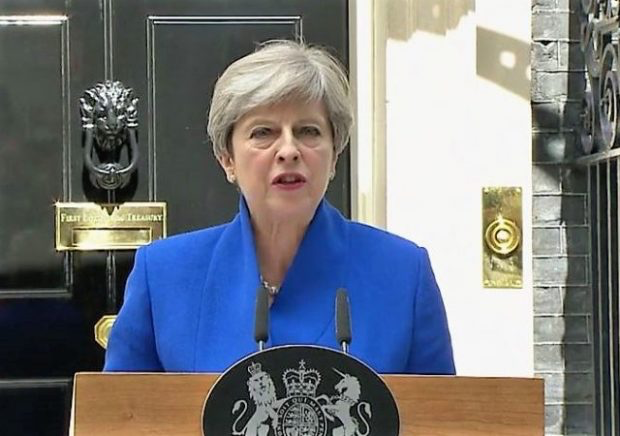
The disaster to Western Civilization from a Jeremy Corbyn Labour Party victory “may” have been averted.
She’s no Margaret Thatcher.
The Telegraph reports:
Theresa May has set out her plans to form a minority government to deliver Brexit in the wake of a disastrous election night for the Conservatives.
Speaking in Downing Street after outlining her intentions to the Queen at Buckingham Palace the Prime Minister said the Tories would work with the Democratic Unionist Party to command a majority in the House of Commons after the Conservatives fell short of winning the 326 seats needed to govern alone.
She said: “What the country needs more than ever is certainty and having secured the largest number of votes and the greatest number of seats in the General Election it is clear that only the Conservative and Unionist Party has the legitimacy and ability to provide that certainty by commanding a majority in the House of Commons.”
Seth Barrett Tillman provided a good analysis of why a “hung” parliament was never likely:
… With 649 of 650 seats declared at this juncture (10 AM BST, June 9, 2017), the Tories have 318 seats.
The three primary opposition parties, Labour (“Lab”), Liberal Democrats (“LibDem”), and Scottish National Party (“SNP”), have 261, 12, and 35 seats respectively. That is a total 308 seats. Add to the 308 the 1 seat not yet declared, and that brings the opposition to 309 seats. Add 1 seat for the Greens, and that brings the opposition to 310 seats. Add 4 independents, and that brings the opposition to 314 seats.
318 + 314 = 632 (out of a 650 seat total)
That still leaves 18 seats for Northern Ireland (“NI”) to enter the mix. 7 seats went Sinn Fein (“SF”), the Irish nationalist party seeking to end the connection between NI and the rest of the UK. 10 seats went to the Democratic Unionist Party (“DUP”) and 1 seat went to an independent unionist candidate (in fact, a former Ulster Unionist Party or UUP member). The SF members will not take their seats and vote against the Tory Government—at least, they never have in the past. And if the SF members did take their seats and vote against the Tory Government, all that would happen would be that the DUP members and the independent unionist member would vote with the Tory Government. The likely result is that SF members will sit out any no confidence motion, and that the 11 NI unionist members will either not vote or vote for the Tory Government.
That leaves the Tory leader (Prime Minister May or her successor) with a 318 to 314 vote on a no confidence motion and a majority of 4.
QED: No hung parliament. And did I mention that DUP, on which the Tory Government is likely to depend, as a practical matter, is proBrexit. What a time to be alive!
How big a disaster would Jeremy Corbyn as Prime Minister have been? When he was elected Labour Party leader in 2015, the Daily Mail wrote:
Jeremy Corbyn is the most radical Labour leader in the party’s history.
The veteran left-winger does not merely advocate a return to 1970s-style socialism, the re-opening of the mines and nationalisation of all public utilities.
Mr Corbyn also opposes Nato, Britain’s nuclear deterrent and any controls on immigration.
He refused to support the Falklands War, backed the right of Iraqi insurgents to target British troops and, more recently, has defended Vladimir Putin, ISIS and Palestinian terrorists.
His views are so hard-line he even split with his second wife because she refused to send her child to the failing local state school in his constituency.